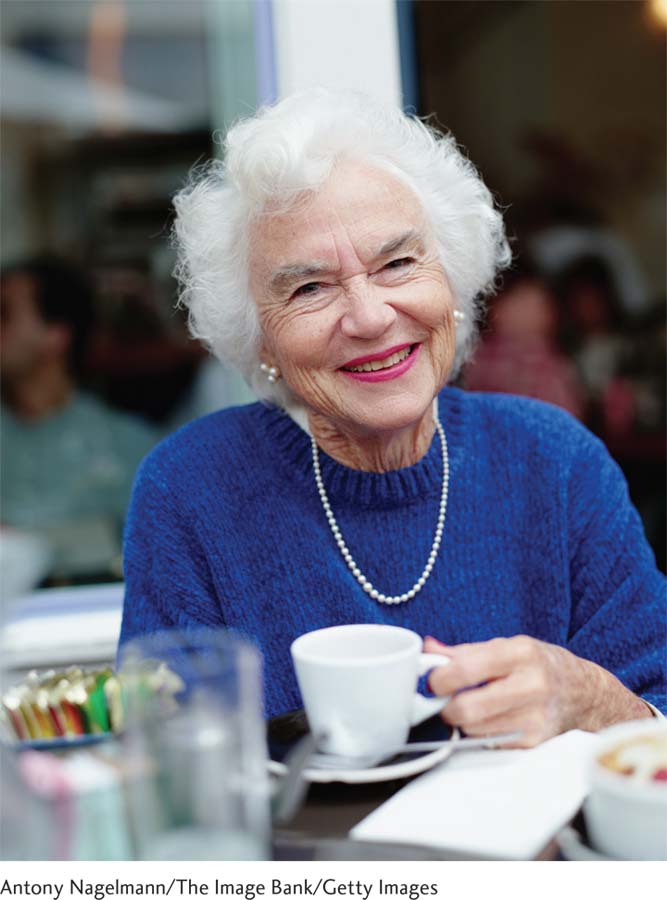416
CHAPTER 14

The Physical Challenges of Old Age
CHAPTER OUTLINE
Tracing Physical Aging
Can We Live to 1,000?
Socioeconomic Status, Aging, and Disease
Gender, Aging, and Disease
INTERVENTIONS: Taking a Holistic Lifespan Disease-
Sensory-Motor Changes
Our Windows on the World: Vision
INTERVENTIONS: Clarifying Sight
Our Bridge to Others: Hearing
INTERVENTIONS: Amplifying Hearing
Motor Performances
INTERVENTIONS: Managing Motor Problems
HOT IN DEVELOPMENTAL SCIENCE: Driving in Old Age
Neurocognitive Disorders (NCDs)
EXPERIENCING THE LIFESPAN: An Insider Describes His Unraveling Mind
The Dimensions of These Disorders
Neurocognitive Disorders’ Two Main Causes
Targeting the Beginnings: The Quest to Nip Alzheimer’s in the Bud
INTERVENTIONS: Dealing with These Devastating Disorders
Options and Services for the Frail Elderly
Setting the Context: Scanning the Global Elder-
Alternatives to Institutions in the United States
Nursing Home Care
EXPERIENCING THE LIFESPAN: Getting It Together in the Nursing Home
A Few Concluding Thoughts
417
At age 76, Susan was vigorous and fit. She walked a mile each day. As the community college’s star pupil, she took classes three days a week. But, Susan was finding it hard to hear her professors because those young students made so much noise! Her night-
Susan’s doctor worried about her atherosclerosis. But it was the vision and bone problems that preoccupied Susan’s thoughts. What if she fell when walking to class, or had an accident on those curving highway exit ramps? When Susan almost backed into a truck on Main Street—
Four years later, at age 80, Susan was having trouble cooking and cleaning. She began to worry: “What will happen when I can’t take care of myself?” Emma, now 50 (and single), urged Susan to move in with her: “I’m buying a condo in this terrific planned community where you don’t need to drive. It has no stairs; I’ll put grab bars in the bathroom. As my adoptive mom, I’d consider it a privilege to help care for you.”
Susan politely said no. She was determined to plan for a future that did not involve burdening loved ones with her care. It was time to check out that beautiful assisted living facility that was advertised as being at the forefront of geriatric care. But after going on Shady Acres website, Susan almost had a heart attack. The average rates ($6,000 a month) were higher than at a four-
Today, Susan uses a walker. It’s hard to get dressed and use the toilet. However, when I visited her, she was surprisingly upbeat. True, life at 83 can be difficult—
What enemy is Susan battling? How does physical aging turn into disease, disability, and sometimes the need for a nursing home? This chapter offers answers to these questions and many more.
In the following pages, I’ll be exploring problems that some gerontologists (for example, Rowe & Kahn, 1998) have labeled as “unsuccessful aging,” describing what goes physically wrong during the old-
Aging successfully means having Jules’s sense of life purpose and generative mission. But, successful aging also depends on whether the wider world offers older people the support they need to function at their best. The issue in later life is not so much being ill, but living fully in the face of chronic disease. The way people function in later life depends on their personal capacities (or nature) combined with nurture—
How can we engineer the right person–